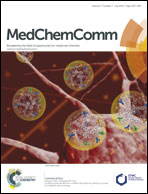Bioactivity of surface tethered Osteogenic Growth Peptide motifs†
Abstract
Osteogenic Growth Peptide (OGP) motifs were tethered to SULFHYDRYL-BIND™ polystyrene plates tuning spatial presentation of the different functional domains. The effects of the different surface-tethered OGP motifs have been evaluated in mesenchymal stem cells (MSCs) osteogenesis. A culture medium without any osteogenic supplements was used in order to evaluate the OGP effect, avoiding any interference by additional factors. The motif YGFGG resulted to be the most interesting, strongly enhancing the expression of BMP2 that plays a fundamental role in bone regeneration. With this study we present new evidence of the role of OGP in osteogenesis and new insights into different OGP motifs able to act as best ligands for the design of innovative bioactive materials for osteogenesis promotion and regenerative medicine applications.


 Please wait while we load your content...
Please wait while we load your content...